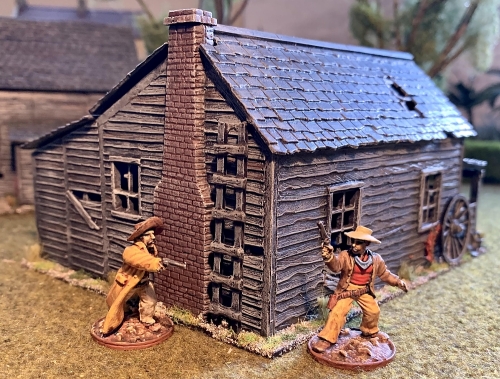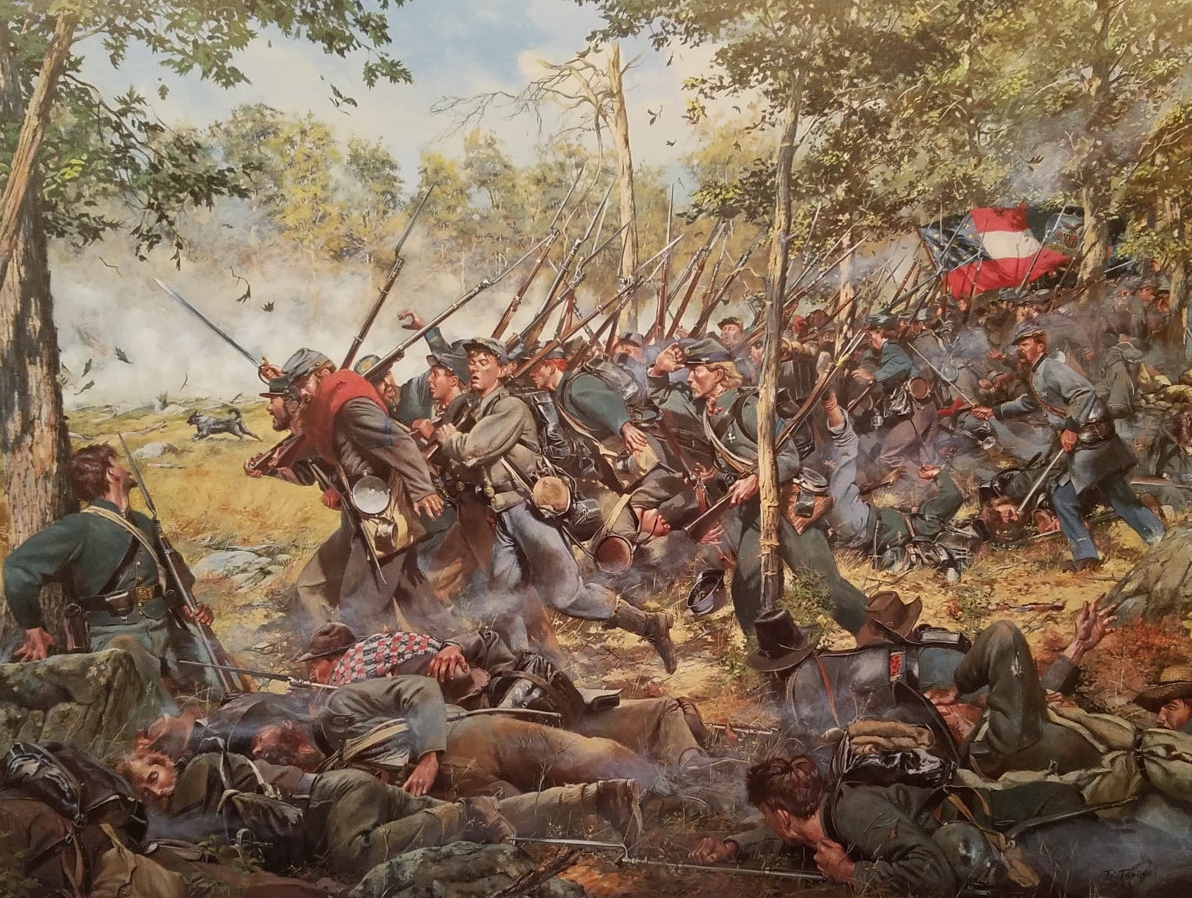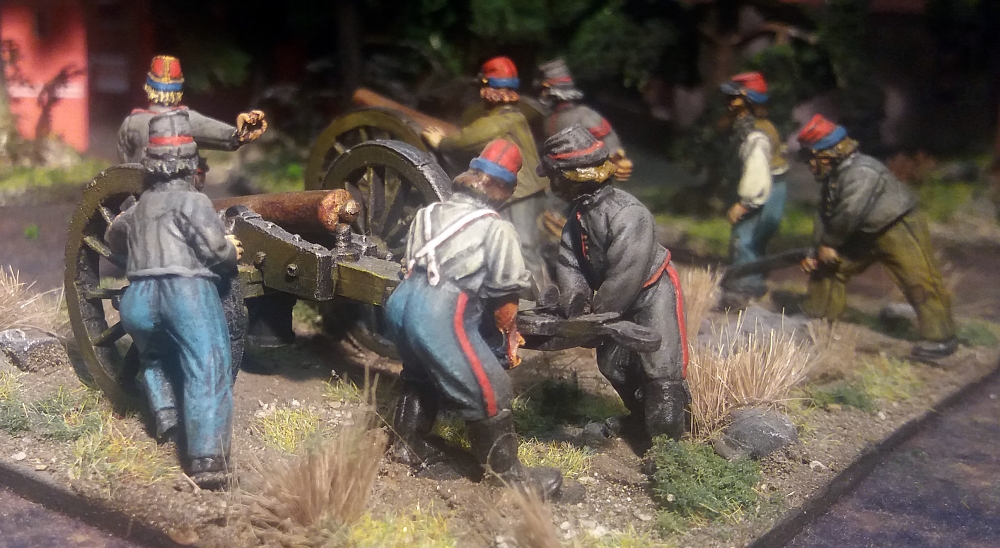Gettysburg, 1998 – 23,000 uniformed reenactors re-fight the great American Civil War battle that took place there 135 years earlier. And this Kiwi was there as a private in the 47th Virginia Infantry.
After the interest displayed in my previous posting on the 2005 reenactment of the Battle of Waterloo, I thought people might also like to find out about my experiences of a few years earlier at one of the biggest reenactments ever held, which took place on the 135th anniversary of the Battle of Gettysburg.
This article was originally posted on my old Gettysburg website. I’ve updated the article and added a whole lot more photos. Some of these pics are pretty impressive when enlarged, so don’t forget to click on them. Note that these images are scanned from my old paper prints – one day I’ll take the negatives to a photographic shop and get better quality digital prints made of them.
Anyway, let’s slip back to the year 1998 (and, with luck, maybe even further back than that to 1863) …

‘Shoulder arms! …Right face! …Forward march!’ shouted our First Sergeant. Hefting my musket onto my shoulder, I stepped forward, keeping in line with the other men of the 47th Virginia Infantry of the Confederate Army of Northern Virginia, who were ranged in two ranks on either side of me. A soldier carrying a bright red flag emblazoned with a blue diagonal cross and white stars marched in front of our formation, while from behind us came the steady rat-a-tat-a-tat of a drum. The sun glinted off our bayonets as they swayed above us in time to our gait.

On either side of our lines, we could see other companies stretching off into the distance, all clad like us in a mixture of well-worn grey and brown uniforms, topped by battered hats of all shapes and sizes.

From my place in the rear rank, I could look over the shoulder of the man in front of me to where, a hundred or so yards in front of us, an apparently solid line of dark blue stretched away on both sides. The glinting of bayonets and the fluttering red-and-white-striped flags showed that this blue line was the waiting enemy.

‘Company! …Halt! …Front!’ came the shouted order. ‘Load!’ I pulled a paper-wrapped cartridge out of the box attached to my belt, stuck it between my teeth, and ripped off the end. Carefully I poured out the black granules of gunpowder down the barrel of the musket, then reached into another pouch on my belt for a small metal primer cap, which I fitted over a nipple near the trigger.
‘Fire by company! …Ready!’ I brought the loaded musket up in front of me. ‘Aim!’ Being careful to ensure that neither the end of the barrel nor the primer cap were right next to the ear of the soldier in front of me, I lifted the musket up and pointed it at the wall of dark blue in front of me. ‘Fire!’ With a sound like ripping canvas, the whole company fired in unison. The effect of this volley on the enemy was impossible to discern, as a blanket of white gun-smoke billowed out in front of us.
I suddenly felt the trappings of the twentieth century disappear. I was experiencing what my fellow reenactors termed a ‘period rush’. I really was a Confederate soldier, it really was 1863, and I really was fighting for my country in Pennsylvania, near a small market-town called Gettysburg!
How did I come to be in Gettysburg like this, feeling as though I had travelled back in time 135 years? The answer to that question has more to do with modern technology than history.
Civil War Re-enacting
The previous year my family had finally joined the Information Age by investing in a smart new computer, complete with Internet connection. Among the software we installed on our machine was the game Sid Meier’s Gettysburg, a recreation of that famous American Civil War battle, fought by tiny animated soldiers across a colourful map.

Making this game even more appealing was the ability to play it over the Internet against opponents all over the world, and so I met (or, to be exact, virtually met) Ed Christopher, a retired US Army officer living in Culpeper, Virginia.
Ed spoke to me about his hobby of reenacting American Civil War battles in real life rather than on computer screens, a pastime I had never heard of. We exchanged a lot of e-mails in which I asked Ed all about his unusual hobby, and in the end Ed invited me to join him and Company I of the 47th Virginia Infantry at the forthcoming 135th anniversary reenactment of the pivotal Battle of Gettysburg.

‘Hot, tired, often miserable, sore feet, dying of thirst, bathed in sweat, eaten up by insects,’ Ed promised me, ‘but it will be the most fun you have ever had in your life!! Just wait until you see (and join) the first massive infantry formations, bayoneted muskets glimmering in the sunlight like a virtual forest of steel, colors flying, and the fifes and drums playing. If you don’t get chills down your spine something’s wrong!’

With the 47th at Gettysburg
The original Battle of Gettysburg took place over three days from July 1-3 in 1863. The Confederate army, under General Robert E Lee was defeated by the Union army commanded by General George Meade, with over 51,000 casualties to both sides. The reenactment took place right next to the original battlefield, and involved 23,000 reenactors, including 700 cavalry and 135 cannons.


There were around 100,000 spectators over the three days of the reenactment. This was the biggest-ever battle reenactment held in the United States.
Reenactors are not real soldiers, but enthusiastic amateurs who do this as a hobby, with clubs portraying various Civil War units spread throughout the United States. I played the role of a private in the 47th Virginia Infantry, a Confederate regiment which really fought at Gettysburg.

My fellow soldiers in the 47th included school teachers, farmers, grocery clerks, active duty and retired US Marines, a lawyer, a retired US Army officer, high school and college students and many others from all walks of life. There were one or two women who were uniformed as men (well enough to hide their gender), and the drummers and fifers were mainly young people.



The reenactors went to great lengths to ensure accuracy. The uniforms were made of the correct heavy wool cloth, right down to the weave. They carried authentic replica weaponry and equipment. Even the shoes had to be replicas of 135 year old brogans.
‘I usually wear a (dirty and stained by the years) butternut sack coat and a pair of filthy and patched gray wool trousers,’ Ed told me. ‘I often sling a filthy patchwork quilt blanket roll over my shoulders, but when it is too hot, I usually leave it off. I always wear a beat-up brown slouch hat. I never clean either my coats or trousers, and they look and smell like it too!’
Accommodation was in period-correct tents with straw for bedding. The camp was situated on a large rolling wooded farm. One could walk for an half-an-hour in any direction and not be out of the confines of the camp.


At night the effect could be magical. ‘The camps are illuminated by hundreds of campfires,’ commented Ed. ‘Meals are cooked in iron skillets and pots over the open fires. Around many of the fires, the boys break out the fiddles and banjos, and we listen to and sing along with all the old Civil War tunes and songs.’
I had to learn how to load and fire the fully-working replica musket, and also how to march in the intricate manoeuvres used on the field of battle in those days. The marching turned out to be easier than I expected, as it did not require the spit and polish expected on modern parade grounds – soldiers of those days ambled in formation, rather than marching, in time to the music of fife-and-drums.

‘There is nothing that will stir your blood more,’ Ed added, ‘than when we march in massive long columns to the fifes and drums. Dense gray and brown columns of Confederates, flags flying, muskets on shoulders (with fixed bayonets gleaming in the sun), that stretch as far as the eye can see; all swaying in time to the fifes and drums playing Bonnie Blue Flag, or Gary Owen, or Dixie, or any of a hundred other tunes, as we march onto the fields. Rebel Yells, screams, and cheers soaring above the columns, dusty hats being wildly waved above heads, and the cheers and applause of tens of thousands of spectators on the sidelines as we march by…. It sends chills down your spine!!!’

Health and Safety
Safety was rigorously enforced. Before every engagement the officers would carefully check every musket. These, of course, were loaded only with gunpowder and no bullets. But there was still the real potential for injury from concussion, paper wadding or unintentional discharges. Closer than fifty yards muskets were to be aimed five feet over the enemy’s heads, not at them. Despite the safety checks, one reenactor was shot in the throat by a bullet accidentally left in an officer’s pistol – fortunately he survived.

Ed warned me that one time when injuries could occur was when fighting for the enemy’s flag. ‘I have grabbed Yankee colors before,’ he explained, ‘but had the sense to clearly let the colorbearer and anyone of his nearby comrades know that it was really for ‘show’ and I wasn’t going anywhere with them……yeah, right!! However, in about every case I was (rightfully) beaten to the ground.’
‘In the making of the movie Gettysburg I went over the wall with General Armistead, and on one of the ‘takes’ found myself face-to-face with the colorbearer – who got a bit too far ahead of his men – of the 72nd Pennsylvania. I ‘bayoneted’ him in the gut, he went down gloriously with his colors, but before I could even hope to touch them, I was literally clubbed to the ground on top of a pile of other bodies. I got up bleeding … and this was for a movie, for God’s sake!’
The other main danger was caused by the extremely high temperatures. There were over 300 cases of heat exhaustion on the first day alone. Our officers often checked that our canteens were full of water and stressed the need to drink often.
How to Die!
The actual engagements were awe-inspiring experiences. I ‘died’ four times during the three days of the battle. In general reenactors ‘took a hit’ when it was obvious that they should. ‘You will notice,’ Ed explained, ‘that often the officers (and the rank and file) will start shouting ‘Take hits, boys!!! We need to take some hits!!’ This is the case when we are clearly in a situation where we should be falling like flies due to the massed musketry and/or cannon fire directed at us. Then, we start to fall here and there or in clusters.’

‘Dying’ was also a good way of just having a rest and enjoying the sights and sounds. Returning to life had to be done very discreetly so that it would not be obvious to spectators. ‘The battle-lines ebb and flow back and forth most of the time,’ Ed told me. ‘If you are lying on the ground dead or wounded, when your own battle-line passes over you again, simply get back on your feet and blend into the mass of men. No one can see you do this from the spectator standpoint, and we all do it. I make a habit of it. Where it really looks unprofessional is when fellows rise back up in the middle of the open field with no one around them, and resume their fight.’
Pickett’s Charge
The highlight of the three days was the reenactment of what has become known as Pickett’s Charge, a doomed frontal attack by the Confederates against the Union infantry and artillery ensconced behind a stone wall. In the real battle, the majority of Confederate troops fell or retreated before they got to this stone wall, but a few did make it over, until they too were killed or captured.
To reenact this turning point in American history, it was important that just as many reenactors fell before they got to the wall. Because every Confederate reenactor wanted the distinction of climbing over the wall, this was done by way of a lottery, with everyone except the winners having to die or retreat before reaching the wall – I was very fortunate to be one of the few who drew a winning number!

There were about 12,000 Confederate reenactors involved in Pickett’s Charge, which meant we were doing a full scale reenactment of the event. We had to cover about half a mile of open ground, before finally reaching the blue-uniformed Federal infantry, lined up about four deep for the entire half-mile or so length of the low stone wall and fenceline.
In silence, each Confederate brigade headed off towards its ‘destiny’. We did a few obliques (diagonal movements) to place ourselves in the correct position, having some problems with our line bowing all the time. It seemed no time at all till we reached the first obstacle, a wooden fence denoting the Emmitsburg Road.
At this point the yell came for those who had drawn ones in the lottery to take a hit. Marching onwards, it must have made an impressive sight to the spectators, as the units shrunk with casualties streaming our behind their trail – it certainly looked it on each side as brigade after brigade of Confederates headed towards the long line of Union soldiers behind their stone wall. (Jill Russell photo)

Down went our twos and threes, our corporal shouting for them to go down. Then at a run, instinctively bowing our heads, hunching our shoulders, and leaning forward as though walking into a headwind, we crossed the final gap towards the stone wall, the fours going down all around us. I clambered up onto the wall, behind which there was a twenty-yard gap, filled already with Confederate and Union ‘bodies’, then the solid line of Union blue. I ran towards them, watching others round me crashing down to the ground.
I felt someone brush past me, and saw it was General Armistead, carrying his hat pierced on the end of his sword (a famous moment in American history). At this moment, I made it to the front cover of the special Gettysburg edition of Civil War News. The photo below depicts General Armistead during Pickett’s Charge, and there I am right beside him! (Julio C Zangroniz photo)

I then decided that it was time I went down myself. I stayed down for a while, watching Union troops shooting, and hearing their ‘Hurrah!’s as the Confederate assault was thrown back. I looked back at the field, which was totally covered with casualties and retreating rebels running back individually and in small groups. There was a group of Confederate and Union soldiers standing near me, so I ‘limped’ over to see what they were looking at. In the centre of the group lay the ‘dying’ General Armistead.
After a while the shooting began to ease off, and it was evident that the battle was at an end. Taps was played on a bugle, and in a very emotional moment, we all, Confederate and Union alike, stopped and took off our caps to honour those real soldiers who fought 135 years ago.

Overall the reenactors were not glorifying war. ‘For most of us,’ commented Ed, ‘this is genuinely stepping back 135 years and seeing and hearing and doing what our great-grandfathers experienced. Many in the ranks claim a direct connection to the war, and Gettysburg in particular. A direct desendant of General George Pickett is in one of the units. We are what we call ‘living historians’ and do our utmost to be very professional about all this. For ourselves, for our forefathers, and for the public who attends.’
To me the sincerity of what they were doing was obvious. Some were honouring those who had fallen (often direct ancestors), some were there to add to their already extensive knowledge of Civil War history, some were genuinely feeling what it was like to live 135 years ago in a time of bitter strife, and some were there more for the simple pleasures of an old-fashioned way of life than for the battles.


All in all, it was amazing to be able to travel not only half-way around the world, but also 135 years back in time. My sincerest thanks for an amazing experience go to Ed Christopher and the men and women of the 47th Virginia Infantry!

I’ve got quite a few more photos of this huge event, so I’ve added another gallery here.






































































































